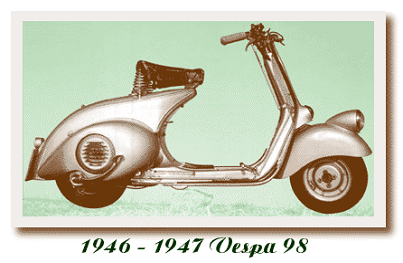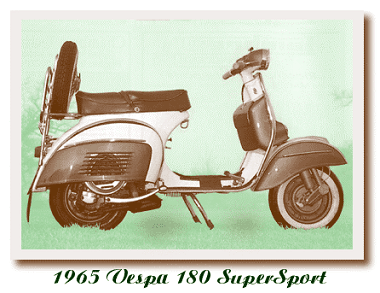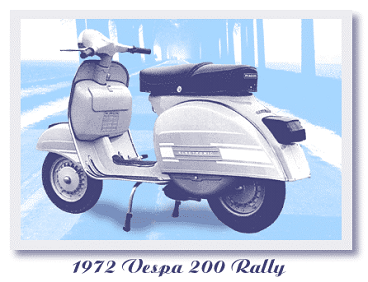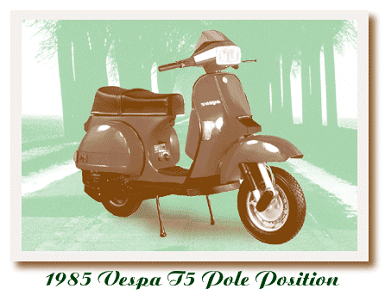
something to get me from A to B
...and then some.
by Jonathan Kang
Not particularly adept at the concept of warfare, the Italians quickly found themselves on the losing end of the Second World War, which was turned out to be a blessing. During the war the Piaggio company had busied itself with the prime business of building airplanes and machines of war. Losing the war meant that there was no more need for the metal presses used in the fabrication of pressed steel plate for aircraft components. Smart Piaggio executives felt that the materials and tools could be used to produce a cheap economical means of transport, something which Italy, ravaged by war, could use.
Many of the new scooter's design quirks and characteristics were due to practicalities. There was no chain-drive, due to a wartime shortage, so the engine of the scooter was bolted directly to the rear wheel. A small 98cc motor provided just about enough power to get the whole contraption and its owner moving. Originally called "Donald Duck" it was eventually renamed in favour of something less silly sounding, and the Vespa ("Wasp" in Italian) was born. Like the Beetle and the Trabant in West and East Germany respectively, the Vespa was a cheap fundamental means of transport and no more.

Achtung Baby: Germany Gets Into the Swing of Things Again
The Vespa quickly grew in popularity due to the practical solutions it offered. This popularity meant that the Italian factory's supply could not keep up with the demand for its new scooters. Popularity in other parts of Europe led to many an enterprising entrepreneur applying for the license to build Vespas under a different badge in their own countries. The German Hoffman company was one of these. Hoffman improved on the fundamental design of the Vespa by correcting the instability of the original (because the engine was mounted more to one side of the frame, resulting in improper weight distribution) and refining the overall package, German style. The Hoffman Model "A" sold for 1220 Deutsche Marks; twice the average worker's monthly salary, but well worth it. A burgeoning accessories market also sprung up, with everything from fancy seats to louder horns. It was the shape of things to come

Sacks And the City
As overall affluence increased, more and more people began packing their bags and moving out of the countryside, into the city. Urban living soon became a fad and the Vespa had a new role to fulfill. Urban living brought with it congestion and shortage of space. A nippy convenient, space saving means of transport would be most useful. Previously the Vespa was seen as a status symbol; now it was a symbol of a new lifestyle, and appreciation of haute couture that came with someone who proudly claimed to live in the city.

Bell Bottom Blues
Tie-dye, patchouli, long
hair, jam music and a controlled substance or two made the 70's and interesting
time to live in. So did owning "real" motorcycles. Truly the Peter
Fondas and Dennis Hoppers of the time could surely not be seen put-putting
around on miniscule little recycled soup cans, could they? The Vespa quickly
fell out of demand, acquiring an image for being ridden only by grandfathers
and poor college students. In an era of excess, there was nothing "Macho"
about the anaemic little wasp. Even the introduction of funky new pin striping
on the "Rally" model could not generate interest and many Vespas
were eventually condemned to the scrap yard. A Vespa brochure declared the
"Natural riding position, large leg shield and full motor cowlings allow
one to ride the scooter in a good suit and stylish clothes" but what
was the point when everybody wanted to be in leather and faded denim? Perhaps
the only redeeming factor for a Vespa at the time was
(according to Das Motorrad's April '76 edition) "The open floorboard
which has enough storage space to transport a case of beer".
Big is Beautiful
Fashion is cyclical, they say, and the college-geek image which was viewed with much derision in the 70's suddenly became in. Everybody wanted to wear white socks, college shoes and polo shirts. Suddenly nobody wore leather, and Piaggio's "Nuova Linea", introduced at the turn of the 80's was a hit with the public. A good formula of classic styling with updated user friendly features and a larger 80cc motor. The 80's also brought with it the "Mod" culture. The Mod film Quadrophenia reinforced the Vespa as the hip mode of transport for the modern youth.

In the early 90's, Piaggio introduced the all new Sfera. At first dismissed as nothing more than a gimmick scooter, the Sfera nevertheless began to win the hearts of young and young-at-heart riders everywhere. The Sfera departed from the norm that people were so used in Piaggio. Constructed primarily of fiberglass and aluminium, the Sfera's elliptical egg-shaped body ultimately ensured that it stood out amongst the crowd. Vespa purists were quick to condemn the new Sfera, saying it bore nothing in common with classic Vespas, but they were forced to acknowledge the new converts to scooterdom which the Sfera brought.
Scootering Today
From the late 90's to modern turn of the century times; the Vespa has again taken on a new image. The present day scooter rider is a dynamic, environmentally-conscious individual who avoids congestion, the beaten track and all things common. Not for the sake of rebelling, as in the 70's, mind you, but for his own benefit. He also appreciates a good machine; one that is easy to ride, cheap to maintain and gives the experience of a great ride. The modern scooter has also changed much in terms of feature and use. The Sfera was Piaggio's first foray into a modern scooter design with its now distinctive egg-shaped lines and automatic transmission. They followed it up with the hexagon, a large, powerful "luxury" scooter meant for longer jaunts. Of course they also kept the classic Vespa models, which were updated for modern demands. Today you can see a busy executive beating the congestion by riding his Hexagon to work, the young student riding his bright yellow Sfera, the scooter junkie who has a lovingly restored early 60's model, or the dispatch rider getting to his destination on a Vespa PK, which is very much like the original.
Foreign Competition
The scooter market has never stayed exclusively Piaggio's for long. As seen in the 50's when Hoffman applied for the first licenses to build Vespa clones in Germany, the concept of a scooter has been taken on by all the big motorcycle firms, which have eventually departed from the lines of the original Vespa to build their own versions of scooters. The Italian Gilera firm has concentrated on sport oriented scooters, and models like the Runner showcase the technical innovations made in scooter design. With extras like powerful disc-brakes, race-tuned exhaust pipes and race engine components, the Gilera is made of lightweight aluminium and fiberglass, offering a lot of power and agility on a bike no larger than a normal scooter. Japanese companies like Honda and Yamaha have come out with numerous touring and luxury models, which offer a more comfortable riding position and increased power for longer trips. Even car maker BMW have launched the C1; a scooter with a roof, windscreen and wiper. BMW steadfastly refuses to call it a scooter, using the self-coined moniker "Urban Concept Vehicle" instead. The latest people to jump on the bandwagon are the Koreans. Companies like Daelim and Hyosung have come up with their own scooter designs which differ greatly from the original Vespa, but still provide the low-cost high-fun approach that has made the Vespa famous. Truly, if you were mention the word "scooter" to anyone, one of the first words on his or her lips would be "Vespa".